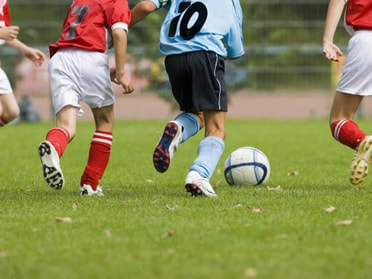|
Soccer is the most popular sport on the globe with over 270 million participants and it’s easy to see why. It is fast, dynamic, exciting and crazy, almost every emotion within 90 mins can be experienced. The performance of a soccer player is made up of many different variables such as tactile, mental, technical and physiological. During a game, elite level players run about 10km at an average intensity close to the anaerobic threshold (80-90% of maximal heart rate). Within this time there are a number of explosive movements including jumping, kicking, tackling, sprinting, turning and deceleration. Strength and power are equally as important as endurance in soccer. Now with this large number people playing and the high demands of the game there will be injuries. Let’s analyse to trends of injuries in soccer and how they can be managed and prevented, paying close attention to ankle sprains Most soccer injuries occur to the lower extremity at approximately 87% and the common injury types include strain, sprain and contusion. The UEFA injury study showed thigh strains makes up 17%, hamstring 12% and ankle sprain 7%. The incidence is higher during the game at 57% making injuries quite high during training at 43%. 16% accounted for more than 28 days away from training and game. 12% with season ending injuries. Another study among amateur soccer players in Spain showed there was an average of 0.11 injuries per player per year. A large number of injuries led to 1 competitive match being missed (87%). Midfielders had the highest injury rate at 34.3%. The knee and ankle making up 42.3% making them the most common injury location. Ligament sprains accounted for 32.1%. Risk factors:
As mentioned, ligament sprains are common within especially in the ankle. 80-90% of ankle injuries are on the outer aspect of the ankle (lateral) with 69% being on the dominant leg. Most of the time the sprains are uncomplicated, however, 60% suffer from a repeated sprain after the initial event. 63.3% occurs with player contact and most occur to defenders. The mechanism of injuring is due to landing, twisting, turning or running which leads to rolling the ankle. How to recognise an ankle sprain:
Acute management of ankle sprain (within 24-72 hours of injury):
Once swelling and pain have decreased begin a rehabilitation program to be able to return to play and decrease the risk of re-occurrence. Prevention strategies for ankle sprains:
References:Lehnhart RA, Lehnhart HR, Young R, et al. Monitoring injuries on a college soccer team: the effect of strength training. J Strength Cond Res 1996; 10 (2): 115–9 Stølen, T., Chamari, K., Castagna, C. et al. Sports Med (2005) 35: 501. https://doi-org.simsrad.net.ocs.mq.edu.au/10.2165/00007256-200535060-00004 Am J Sports Med. 2014 Jan;42(1):78-85. doi: 10.1177/0363546513507767. Epub 2013 Oct 17. Injuries among Spanish male amateur soccer players: a retrospective population study. Ryynänen J, Dvorak J, Peterson L, et al Increased risk of injury following red and yellow cards, injuries and goals in FIFA World Cups Br J Sports Med 2013;47:970-973. Walls RJ, Ross KA, Fraser EJ, et al. Football injuries of the ankle: A review of injury mechanisms, diagnosis and management. World J Orthop. 2016;7(1):8–19. Published 2016 Jan 18. doi:10.5312/wjo.v7.i1.8 Med Sci Sports Exerc. 1999 Jul;31(7 Suppl):S470-86. Foot and ankle problems in the young athlete. Kofotolis, N. D., Kellis, E., & Vlachopoulos, S. P. (2007). Ankle Sprain Injuries and Risk Factors in Amateur Soccer Players during a 2-Year Period. The American Journal of Sports Medicine, 35(3), 458–466. https://doi.org/10.1177/0363546506294857 Safran MR , Benedetti RS , Bartolozzi AR 3rd , Mandelbaum BR Medicine and Science in Sports and Exercise [01 Jul 1999, 31(7 Suppl):S429-37] Lateral ankle sprains: a comprehensive review: part 1: etiology, pathoanatomy, histopathogenesis, and diagnosis. 
0 Comments
Leave a Reply. |
Archives
June 2021
|
|
Contact Details
Call 9542 3330
99A Loftus Ave, Loftus NSW 2232 Hours Monday & Wednesday 8am - 6pm Saturday: 8am - 12pm Early morning or later evening available by appointment Our reception is available for walk-ins on Monday, Wednesday & Saturday. Or by telephone 7 days. |



 RSS Feed
RSS Feed